Here is an image of my circuit.
Here is another image of my circuit.
Here is ANOTHER image of my circuit.
Here is an image of my casing cut out.
Here is an image of my circuit inside my casing.
Here is what the final product looked like.
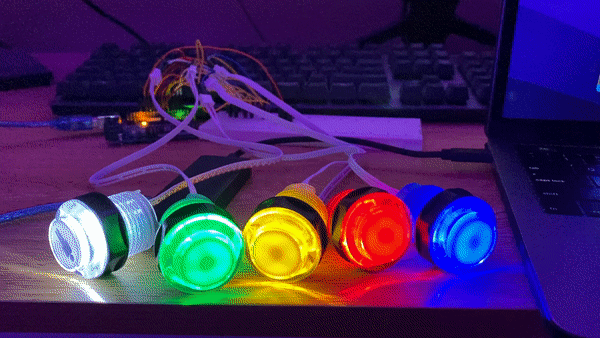
Here is a gif of my circuit working. The white button is pressed to start the game. Then, colors will begin turning off and the player must press the buttons in the order they were turned off in. More and more buttons get turned off in the sequence as the players memorizes and presses the sequence correctly until the user reaches 100 button presses correct in a row or gets one wrong. When the game ends, all buttons will turn off. In addition, when buttons are pressed and the game ends, an active buzzer will make a distinct corresponding sound.
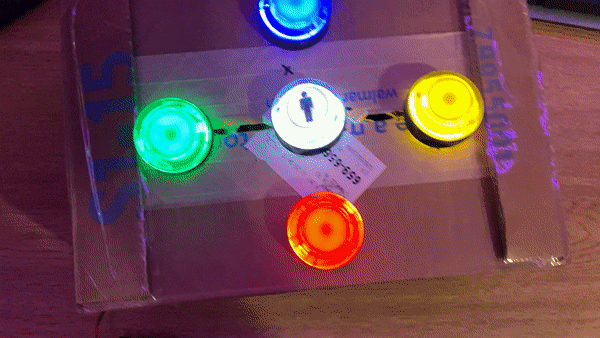
Here is a another gif of my circuit working. During the building phase I had a few requirements. I wanted to have the four main game buttons symmetrical and ordered to reduce the amount of visual distraction during a memory game. I also wanted the start button to be centered and appear different than the other game buttons to ensure users knew that it was a start button. The power for the game needed to be outside of the casing to allow power to be replaced easily if it runs out. Lastly, I did not want to spend too much on this project, so I cheaped out with the casing by using a cardboard box. In terms of usability, there were also a few things I thought about. I chose to use arcade buttons for better feel and touch when playing and increase tactile sensory. Furthermore, I used different color buttons for contrast and visual recognition. I chose to also add a buzzer to reinforce memory with audio cues, which is useful for those with difficulty seeing. Click here to watch a video of me playing. Click here to watch a video of my mom playing.
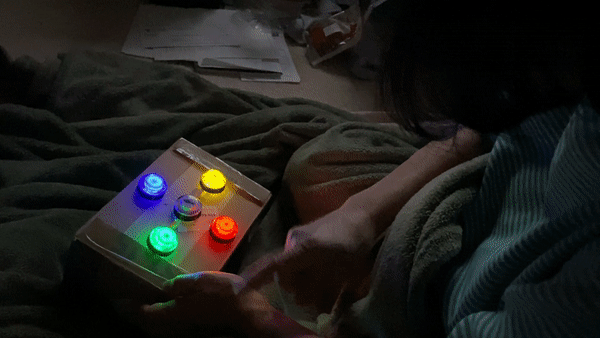
Here is my mom playing (for funsies)!
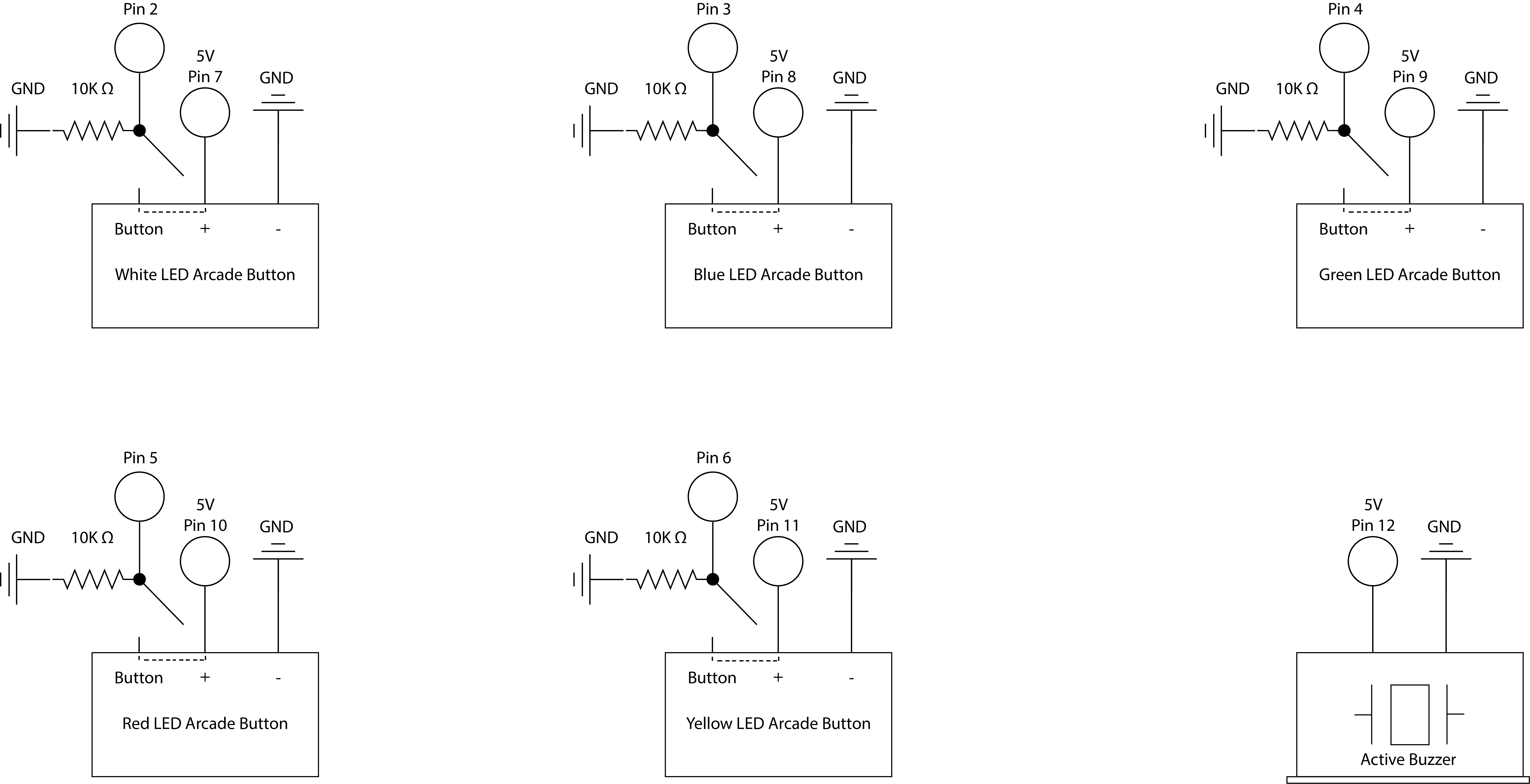
Inside each arcade button are two small LEDs. These internal LEDs have their own unknown resistor built inside, but according to data from other users, works fine with 5V of power, which is why I did not use a resistor between the power and ground pins. This is also why I chose to use pins 7 - 11 as a digitalOutput to control when the buttons/ LEDs were on or off. Since the buttons had a pin that connected to power, and one that connected to ground, I knew the other pin was used to read when the button was pressed. I used a 10k ohm resistor for this last pin on every button to ensure that the input does not float between 0v and 5v AKA to keep pins 2 - 6 grounded when the switch was open. This allowed me to read when the switch was closed AKA when the arcade buttons were pressed with digitalInput. The active buzzer was connected to a pin to control the tone of the buzzer corresponding to each button and when the game ended.
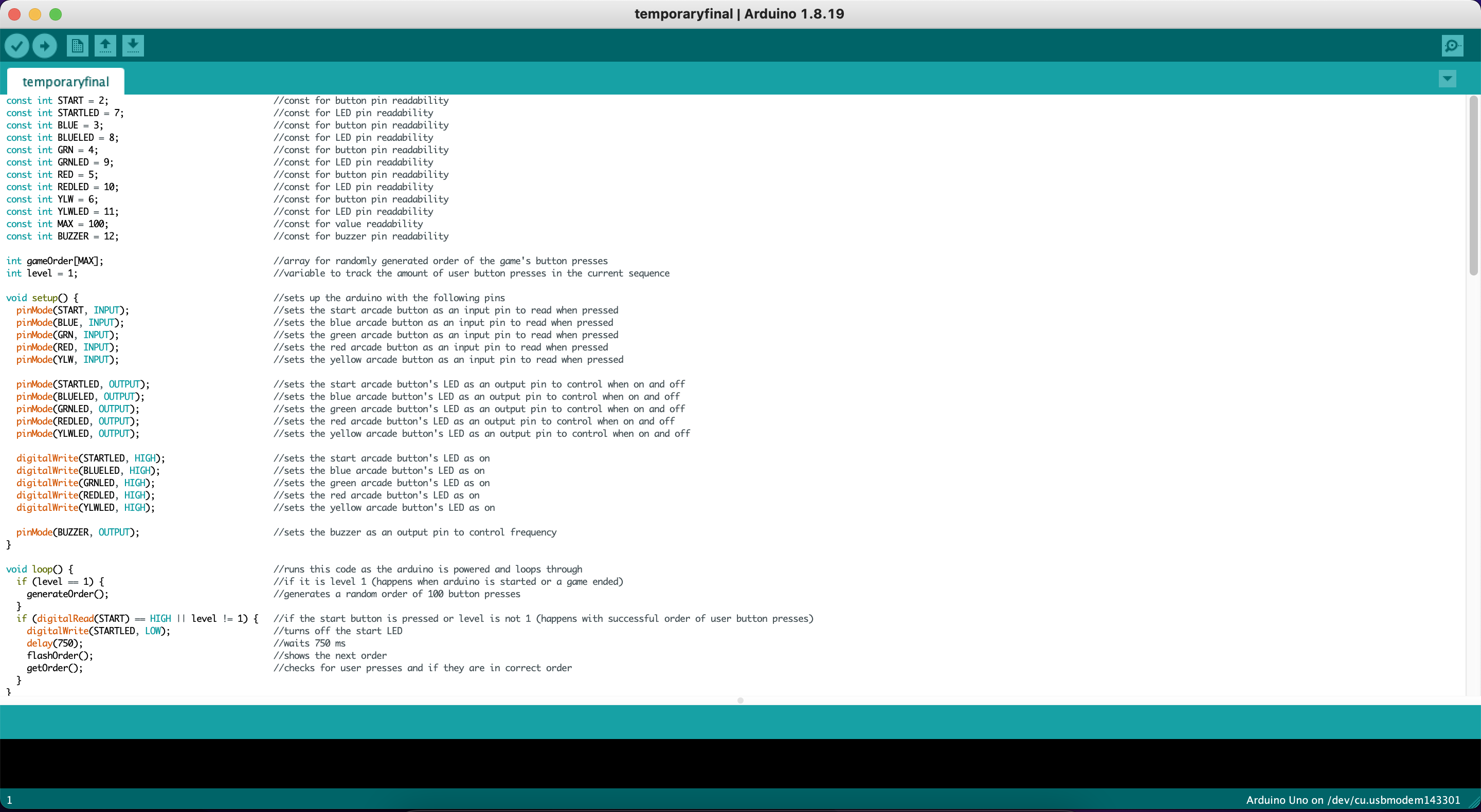
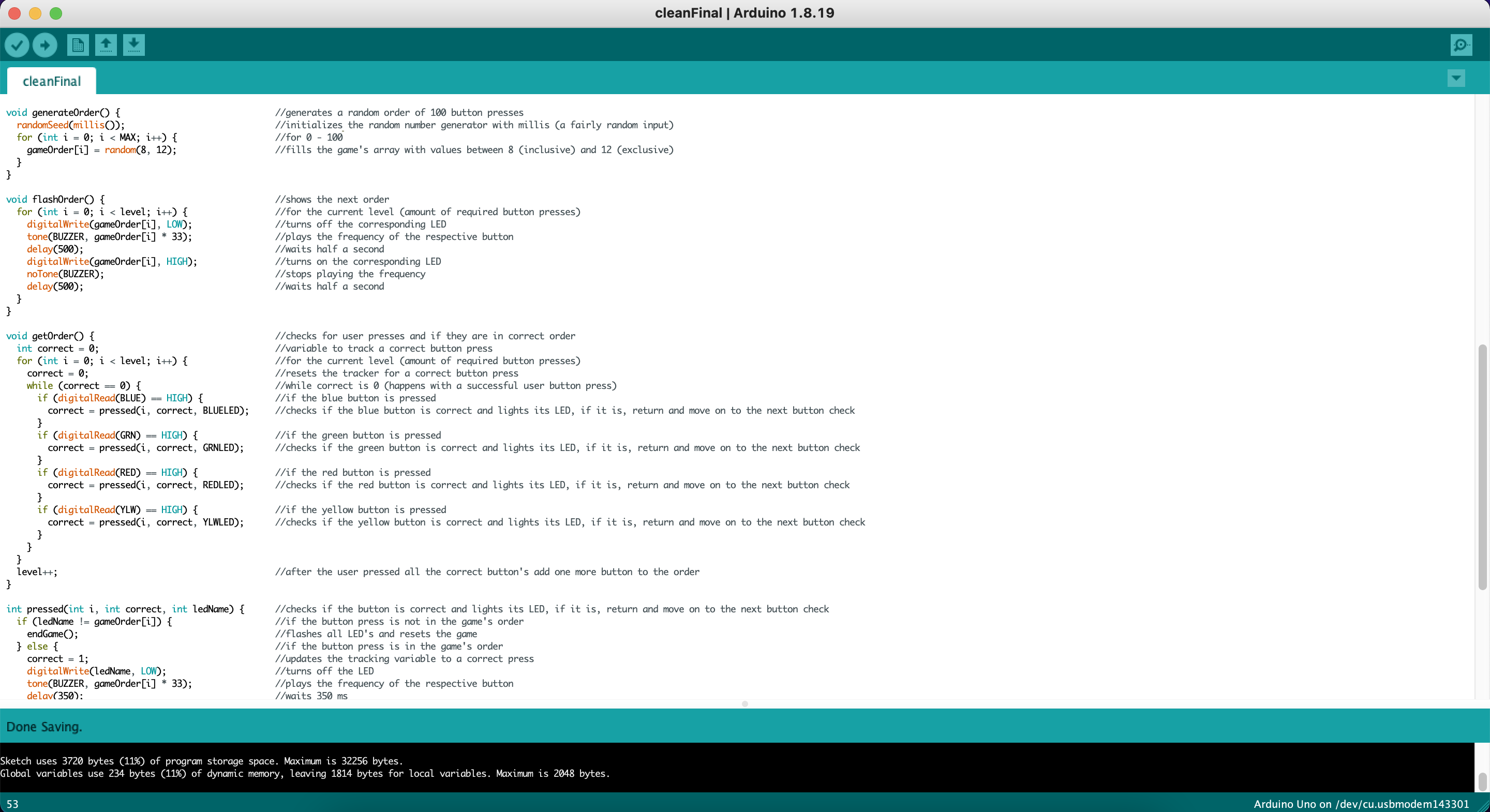

Arduino
const int START = 2; //const for button pin readability
const int STARTLED = 7; //const for LED pin readability
const int BLUE = 3; //const for button pin readability
const int BLUELED = 8; //const for LED pin readability
const int GRN = 4; //const for button pin readability
const int GRNLED = 9; //const for LED pin readability
const int RED = 5; //const for button pin readability
const int REDLED = 10; //const for LED pin readability
const int YLW = 6; //const for button pin readability
const int YLWLED = 11; //const for LED pin readability
const int MAX = 100; //const for value readability
const int BUZZER = 12; //const for buzzer pin readability
int gameOrder[MAX]; //array for randomly generated order of the game's button presses
int level = 1; //variable to track the amount of user button presses in the current sequence
void setup() { //sets up the arduino with the following pins
pinMode(START, INPUT); //sets the start arcade button as an input pin to read when pressed
pinMode(BLUE, INPUT); //sets the blue arcade button as an input pin to read when pressed
pinMode(GRN, INPUT); //sets the green arcade button as an input pin to read when pressed
pinMode(RED, INPUT); //sets the red arcade button as an input pin to read when pressed
pinMode(YLW, INPUT); //sets the yellow arcade button as an input pin to read when pressed
pinMode(STARTLED, OUTPUT); //sets the start arcade button's LED as an output pin to control when on and off
pinMode(BLUELED, OUTPUT); //sets the blue arcade button's LED as an output pin to control when on and off
pinMode(GRNLED, OUTPUT); //sets the green arcade button's LED as an output pin to control when on and off
pinMode(REDLED, OUTPUT); //sets the red arcade button's LED as an output pin to control when on and off
pinMode(YLWLED, OUTPUT); //sets the yellow arcade button's LED as an output pin to control when on and off
digitalWrite(STARTLED, HIGH); //sets the start arcade button's LED as on
digitalWrite(BLUELED, HIGH); //sets the blue arcade button's LED as on
digitalWrite(GRNLED, HIGH); //sets the green arcade button's LED as on
digitalWrite(REDLED, HIGH); //sets the red arcade button's LED as on
digitalWrite(YLWLED, HIGH); //sets the yellow arcade button's LED as on
pinMode(BUZZER, OUTPUT); //sets the buzzer as an output pin to control frequency
}
void loop() { //runs this code as the arduino is powered and loops through
if (level == 1) { //if it is level 1 (happens when arduino is started or a game ended)
generateOrder(); //generates a random order of 100 button presses
}
if (digitalRead(START) == HIGH || level != 1) { //if the start button is pressed or level is not 1 (happens with successful order of user button presses)
digitalWrite(STARTLED, LOW); //turns off the start LED
delay(750); //waits 750 ms
flashOrder(); //shows the next order
getOrder(); //checks for user presses and if they are in correct order
}
}
void generateOrder() { //generates a random order of 100 button presses
randomSeed(millis()); //initializes the random number generator with millis (a fairly random input)
for (int i = 0; i < MAX; i++) { //for 0 - 100
gameOrder[i] = random(8, 12); //fills the game's array with values between 8 (inclusive) and 12 (exclusive)
}
}
void flashOrder() { //shows the next order
for (int i = 0; i < level; i++) { //for the current level (amount of required button presses)
digitalWrite(gameOrder[i], LOW); //turns off the corresponding LED
tone(BUZZER, gameOrder[i] * 33); //plays the frequency of the respective button
delay(500); //waits half a second
digitalWrite(gameOrder[i], HIGH); //turns on the corresponding LED
noTone(BUZZER); //stops playing the frequency
delay(500); //waits half a second
}
}
void getOrder() { //checks for user presses and if they are in correct order
int correct = 0; //variable to track a correct button press
for (int i = 0; i < level; i++) { //for the current level (amount of required button presses)
correct = 0; //resets the tracker for a correct button press
while (correct == 0) { //while correct is 0 (happens with a successful user button press)
if (digitalRead(BLUE) == HIGH) { //if the blue button is pressed
correct = pressed(i, correct, BLUELED); //checks if the blue button is correct and lights its LED, if it is, return and move on to the next button check
}
if (digitalRead(GRN) == HIGH) { //if the green button is pressed
correct = pressed(i, correct, GRNLED); //checks if the green button is correct and lights its LED, if it is, return and move on to the next button check
}
if (digitalRead(RED) == HIGH) { //if the red button is pressed
correct = pressed(i, correct, REDLED); //checks if the red button is correct and lights its LED, if it is, return and move on to the next button check
}
if (digitalRead(YLW) == HIGH) { //if the yellow button is pressed
correct = pressed(i, correct, YLWLED); //checks if the yellow button is correct and lights its LED, if it is, return and move on to the next button check
}
}
}
level++; //after the user pressed all the correct button's add one more button to the order
}
int pressed(int i, int correct, int ledName) { //checks if the button is correct and lights its LED, if it is, return and move on to the next button check
if (ledName != gameOrder[i]) { //if the button press is not in the game's order
endGame(); //flashes all LED's and resets the game
} else { //if the button press is in the game's order
correct = 1; //updates the tracking variable to a correct press
digitalWrite(ledName, LOW); //turns off the LED
tone(BUZZER, gameOrder[i] * 33); //plays the frequency of the respective button
delay(350); //waits 350 ms
digitalWrite(ledName, HIGH); //turns on the LED
noTone(BUZZER); //stops playing the frequency
return correct; //returns the tracking variable to the previous function to notify a correct press
}
}
void endGame() { //flashes all LED's and resets the game
digitalWrite(BLUELED, LOW); //turns off the blue LED
digitalWrite(GRNLED, LOW); //turns off the green LED
digitalWrite(REDLED, LOW); //turns off the red LED
digitalWrite(YLWLED, LOW); //turns off the yellow LED
tone(BUZZER, 440); //plays a frequency of 440
delay(3000); //waits three seconds
digitalWrite(STARTLED, HIGH); //turns on the start LED
digitalWrite(BLUELED, HIGH); //turns on the blue LED
digitalWrite(GRNLED, HIGH); //turns on the green LED
digitalWrite(REDLED, HIGH); //turns on the red LED
digitalWrite(YLWLED, HIGH); //turns on the yellow LED
noTone(BUZZER); //stops playing the frequency
level = 0; //resets the game
}
How this code works is that for each button, there are two pins needed. One is needed for reading when the button is pressed and another pin is needed to control when the button and LED of the button is off. The buzzer needed to be an output that way the Arduino could control the sound of it through its frequency. These were all initiated during the setup. Then, the Arduino goes through the loop() which generates random values between 8 (inclusive) and 12 (exclusive) and puts them into an array of size 100. Then, if the start button is pressed, it begins flashing the order of the buttons that need to be pressed based on the value within the array of size 100. It will only flash as many buttons as the level requires, which increments by one each time a sequence is pressed correctly. Then the Arduino waits for user input through a while loop and uses a variable called "correct" that allows the Arduino to constantly check for button presses and stops the code from accepting other inputs or running other code. When a button is pressed, a sound is played, the button is turned off temporarily and then the variable "correct" is updated to allow the Arduino to check for the next button press. This continues until a button press during the while loop is incorrect, and if it is, the level is reset and the game ends with all the buttons turned off for two seconds and the buttons turned off. The game resets and then can be played again.